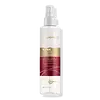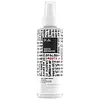What's inside
What's inside
 Key Ingredients
Key Ingredients

 Benefits
Benefits

 Concerns
Concerns

 Ingredients Side-by-side
Ingredients Side-by-side

Water
Skin ConditioningCyclopentasiloxane
EmollientDimethicone
EmollientC12-15 Alkyl Benzoate
AntimicrobialCinnamidopropyltrimonium Chloride
PEG/PPG-15/15 Dimethicone
EmulsifyingKeratin
Skin ConditioningHydrolyzed Keratin
HumectantLaurdimonium Hydroxypropyl Hydrolyzed Keratin
Skin ConditioningAvena Sativa Peptide
Skin ConditioningArginine Hcl
Skin ConditioningArginine
MaskingRosa Canina Fruit Oil
EmollientArgania Spinosa Kernel Oil
EmollientSchinziophyton Rautanenii Kernel Oil
EmollientHydrolyzed Keratin Pg-Propylmethylsilanediol
Skin ConditioningAllantoin
Skin ConditioningAloe Barbadensis Leaf Juice
Skin ConditioningPhosphatidylcholine
EmulsifyingButyl Methoxydibenzoylmethane
UV AbsorberOenothera Biennis Oil
EmollientCocodimonium Hydroxypropyl Hydrolyzed Keratin
Skin ConditioningPsidium Guajava Fruit Extract
AstringentAleurites Moluccanus Seed Oil
Skin ConditioningThioctic Acid
AntioxidantGlycolipids
Skin ConditioningTocopheryl Acetate
AntioxidantHydrogenated Castor Oil/Sebacic Acid Copolymer
EmollientDipropylene Glycol
HumectantPolysorbate 20
EmulsifyingC10-40 Isoalkylamidopropylethyldimonium Ethosulfate
PEG-40 Hydrogenated Castor Oil
EmulsifyingCetrimonium Chloride
AntimicrobialCocamidopropyl Betaine
CleansingPolyquaternium-11
Sodium Hyaluronate
HumectantCitric Acid
BufferingTetrasodium EDTA
Polysilicone-19
Glycerin
HumectantPolyquaternium-55
Sodium Ascorbyl Phosphate
AntioxidantAminomethyl Propanol
BufferingCaprylhydroxamic Acid
1,2-Hexanediol
Skin ConditioningPropanediol
SolventPhenoxyethanol
PreservativeSodium Benzoate
MaskingBenzyl Alcohol
PerfumingBenzoic Acid
MaskingHydroxycitronellal
PerfumingLinalool
PerfumingAlpha-Isomethyl Ionone
PerfumingCoumarin
PerfumingCinnamyl Alcohol
PerfumingParfum
MaskingWater, Cyclopentasiloxane, Dimethicone, C12-15 Alkyl Benzoate, Cinnamidopropyltrimonium Chloride, PEG/PPG-15/15 Dimethicone, Keratin, Hydrolyzed Keratin, Laurdimonium Hydroxypropyl Hydrolyzed Keratin, Avena Sativa Peptide, Arginine Hcl, Arginine, Rosa Canina Fruit Oil, Argania Spinosa Kernel Oil, Schinziophyton Rautanenii Kernel Oil, Hydrolyzed Keratin Pg-Propylmethylsilanediol, Allantoin, Aloe Barbadensis Leaf Juice, Phosphatidylcholine, Butyl Methoxydibenzoylmethane, Oenothera Biennis Oil, Cocodimonium Hydroxypropyl Hydrolyzed Keratin, Psidium Guajava Fruit Extract, Aleurites Moluccanus Seed Oil, Thioctic Acid, Glycolipids, Tocopheryl Acetate, Hydrogenated Castor Oil/Sebacic Acid Copolymer, Dipropylene Glycol, Polysorbate 20, C10-40 Isoalkylamidopropylethyldimonium Ethosulfate, PEG-40 Hydrogenated Castor Oil, Cetrimonium Chloride, Cocamidopropyl Betaine, Polyquaternium-11, Sodium Hyaluronate, Citric Acid, Tetrasodium EDTA, Polysilicone-19, Glycerin, Polyquaternium-55, Sodium Ascorbyl Phosphate, Aminomethyl Propanol, Caprylhydroxamic Acid, 1,2-Hexanediol, Propanediol, Phenoxyethanol, Sodium Benzoate, Benzyl Alcohol, Benzoic Acid, Hydroxycitronellal, Linalool, Alpha-Isomethyl Ionone, Coumarin, Cinnamyl Alcohol, Parfum
Water
Skin ConditioningCetearyl Alcohol
EmollientSilicone Quaternium-8
Spirulina Maxima Extract
SmoothingCocos Nucifera Oil
MaskingGlycerin
HumectantPanthenol
Skin ConditioningRosa Canina Seed Oil
EmollientSalvia Hispanica Seed Oil
MoisturisingHelianthus Annuus Seed Extract
Skin ConditioningRosa Centifolia Flower Water
Skin ConditioningSambucus Nigra Flower Water
Skin ConditioningGlycolic Acid
BufferingBehentrimonium Methosulfate
PEG-12 Dimethicone
Skin ConditioningTrideceth-10
CleansingPotassium Sorbate
PreservativePolyquaternium-59
UV AbsorberCetrimonium Chloride
AntimicrobialButylene Glycol
HumectantSodium PCA
HumectantSodium Lactate
BufferingArginine
MaskingAspartic Acid
MaskingCystine Bis-Pg-Propyl Silanetriol
Skin ConditioningPCA
HumectantGlycine
BufferingAlanine
MaskingSerine
MaskingValine
MaskingIsoleucine
Skin ConditioningProline
Skin ConditioningThreonine
Citric Acid
BufferingHistidine
HumectantPhenylalanine
MaskingSodium Benzoate
MaskingParfum
MaskingPhenoxyethanol
PreservativeEthylhexylglycerin
Skin ConditioningWater, Cetearyl Alcohol, Silicone Quaternium-8, Spirulina Maxima Extract, Cocos Nucifera Oil, Glycerin, Panthenol, Rosa Canina Seed Oil, Salvia Hispanica Seed Oil, Helianthus Annuus Seed Extract, Rosa Centifolia Flower Water, Sambucus Nigra Flower Water, Glycolic Acid, Behentrimonium Methosulfate, PEG-12 Dimethicone, Trideceth-10, Potassium Sorbate, Polyquaternium-59, Cetrimonium Chloride, Butylene Glycol, Sodium PCA, Sodium Lactate, Arginine, Aspartic Acid, Cystine Bis-Pg-Propyl Silanetriol, PCA, Glycine, Alanine, Serine, Valine, Isoleucine, Proline, Threonine, Citric Acid, Histidine, Phenylalanine, Sodium Benzoate, Parfum, Phenoxyethanol, Ethylhexylglycerin
Alternatives
Ingredients Explained
These ingredients are found in both products.
Ingredients higher up in an ingredient list are typically present in a larger amount.
Arginine is an amino acid that is important for human development. Your body uses is it to produce hair keratin and skin collagen.
As a cosmetic ingredient, Arginine has antioxidant properties and can also help repair damaged skin. This ingredient is derived either synthetically or from animals.
Arginine isn't fungal acne safe when used in the presence of other lipids (fats, fatty acids, oils, esters, etc). Oils and fats occur naturally within the skin, so take caution when using Arginine if you're prone to fungal acne.
Learn more about ArginineThis ingredient is a preservative, antimicrobial, and emulsifier. It is often used in cosmetics for its ability to cleanse, condition, and reduce static.
Cetrimonium chloride is a quaternary ammonium salt, meaning it has a water-soluble structure.
Citric Acid is an alpha hydroxy acid (AHA) naturally found in citrus fruits like oranges, lemons, and limes.
Like other AHAs, citric acid can exfoliate skin by breaking down the bonds that hold dead skin cells together. This helps reveal smoother and brighter skin underneath.
However, this exfoliating effect only happens at high concentrations (20%) which can be hard to find in cosmetic products.
Due to this, citric acid is usually included in small amounts as a pH adjuster. This helps keep products slightly more acidic and compatible with skin's natural pH.
In skincare formulas, citric acid can:
While it can provide some skin benefits, research shows lactic acid and glycolic acid are generally more effective and less irritating exfoliants.
Most citric acid used in skincare today is made by fermenting sugars (usually from molasses). This synthetic version is identical to the natural citrus form but easier to stabilize and use in formulations.
Read more about some other popular AHA's here:
Learn more about Citric AcidGlycerin is already naturally found in your skin. It helps moisturize and protect your skin.
A study from 2016 found glycerin to be more effective as a humectant than AHAs and hyaluronic acid.
As a humectant, it helps the skin stay hydrated by pulling moisture to your skin. The low molecular weight of glycerin allows it to pull moisture into the deeper layers of your skin.
Hydrated skin improves your skin barrier; Your skin barrier helps protect against irritants and bacteria.
Glycerin has also been found to have antimicrobial and antiviral properties. Due to these properties, glycerin is often used in wound and burn treatments.
In cosmetics, glycerin is usually derived from plants such as soybean or palm. However, it can also be sourced from animals, such as tallow or animal fat.
This ingredient is organic, colorless, odorless, and non-toxic.
Glycerin is the name for this ingredient in American English. British English uses Glycerol/Glycerine.
Learn more about GlycerinParfum is a catch-all term for an ingredient or more that is used to give a scent to products.
Also called "fragrance", this ingredient can be a blend of hundreds of chemicals or plant oils. This means every product with "fragrance" or "parfum" in the ingredients list is a different mixture.
For instance, Habanolide is a proprietary trade name for a specific aroma chemical. When used as a fragrance ingredient in cosmetics, most aroma chemicals fall under the broad labeling category of “FRAGRANCE” or “PARFUM” according to EU and US regulations.
The term 'parfum' or 'fragrance' is not regulated in many countries. In many cases, it is up to the brand to define this term.
For instance, many brands choose to label themselves as "fragrance-free" because they are not using synthetic fragrances. However, their products may still contain ingredients such as essential oils that are considered a fragrance by INCI standards.
One example is Calendula flower extract. Calendula is an essential oil that still imparts a scent or 'fragrance'.
Depending on the blend, the ingredients in the mixture can cause allergies and sensitivities on the skin. Some ingredients that are known EU allergens include linalool and citronellol.
Parfum can also be used to mask or cover an unpleasant scent.
The bottom line is: not all fragrances/parfum/ingredients are created equally. If you are worried about fragrances, we recommend taking a closer look at an ingredient. And of course, we always recommend speaking with a professional.
Learn more about ParfumPhenoxyethanol is a preservative that has germicide, antimicrobial, and aromatic properties. Studies show that phenoxyethanol can prevent microbial growth. By itself, it has a scent that is similar to that of a rose.
It's often used in formulations along with Caprylyl Glycol to preserve the shelf life of products.
Sodium Benzoate is a preservative. It's used in both cosmetic and food products to inhibit the growth of mold and bacteria. It is typically produced synthetically.
Both the US FDA and EU Health Committee have approved the use of sodium benzoate. In the US, levels of 0.1% (of the total product) are allowed.
Sodium benzoate works as a preservative by inhibiting the growth of bacteria inside of cells. It prevents the cell from fermenting a type of sugar using an enzyme called phosphofructokinase.
It is the salt of benzoic acid. Foods containing sodium benzoate include soda, salad dressings, condiments, fruit juices, wines, and snack foods.
Studies for using ascorbic acid and sodium benzoate in cosmetics are lacking, especially in skincare routines with multiple steps.
We always recommend speaking with a professional, such as a dermatologist, if you have any concerns.
Learn more about Sodium BenzoateWater. It's the most common cosmetic ingredient of all. You'll usually see it at the top of ingredient lists, meaning that it makes up the largest part of the product.
So why is it so popular? Water most often acts as a solvent - this means that it helps dissolve other ingredients into the formulation.
You'll also recognize water as that liquid we all need to stay alive. If you see this, drink a glass of water. Stay hydrated!
Learn more about Water